Lustreflex
The Lustreflex (ラスターフレックス) are Japanese 6×6 TLR cameras, at least some of which were made by Lustre.
Contents
Common features
The Lustreflex is a regular copy of the Rolleicord. The front plate moves back and forth for focusing. The focusing and film advance knobs are on the photographer's right. The name Lustre flex is inscribed on a stepped nameplate above the front plate, and there is a Lustre logo above the viewing hood.
The release button is placed at the bottom of the front standard, on the photographer's right, and the synch post is buried in the opposite side of the front plate. It seems that all the models have an accessory shoe.
The Lustreflex I
The Lustreflex I has semi-automatic film advance. It was only briefly mentioned in an advertisement dated April 1955:[1] the Lustreflex A was presented as a new model and the Lustreflex I as "produced and sold as before" (従来通り製作、販売). It was offered with a choice of two shutters:
- Compur type (B, 1–500), certainly the Lustre-Rapid shutter;
- Prontor type (B, 1–300), certainly the Lustre shutter.
The price of ¥16,000 was given for one of the two options, but it is unclear which one. No picture of this model has yet been observed.
The Lustreflex A
The Lustreflex A is a simpler model, with film advance controlled by red window. There is a magnifying lens and a sportsfinder in the viewing hood. The lenses are Lustre Anastigmat 80/3.5 and the shutter is of the Prontor type (B, 1–200, self-timer). It was advertisement for ¥13,000 in the April 1955 issue of Sankei Camera as cited above and in the following month.[2] No surviving example has been observed so far.
The Lustreflex S
The Lustreflex S is a more expensive model, with semi-automatic advance, double exposure prevention and bayonet filter attachments. It does not seem to have a sportsfinder. The advertisements mention an anti-flare device, probably consisting of anti-reflection walls in the exposure chamber.[3] One source mentions a ahutter lock but this is unconfirmed.[4] The lenses are Lustre 80/3.2 and the shutter is a five-bladed Lustre (B, 1–300, self-timer). The Lustreflex S was announced as a new model in the May 1955 advertisement cited above, and the price was ¥16,000. Its next appearance in Japanese magazines was in the March 1956 issue of Sankei Camera, perhaps because the actual production was delayed by some months.[5] No surviving example has been observed so far.
The Lustreflex C
The Lustreflex C is an intermediate model. It has the semi-automatic advance, double exposure prevention and anti-flare device of the model S, but it takes simple push-on filters.[6] It also adds a sportsfinder, and the shutter lock seems to have disappeared. The lenses are Lustre 80/3.5 and the shutter is a Lustre (B, 1–200, self-timer) as on the model A. The model C was offered for ¥11,000 in an advertisement dated June 1955.[7] It was advertised in Japanese magazines until December of the same year.[8] The only surviving example observed so far is pictured in Sugiyama.[9] From this picture and the advertisements' pictures, the camera looks identical to the semi-automatic Elegaflex. The latter is known with a Lustre shutter (B, 1–300) and is certainly a name variant of the Lustreflex C.
The Lustreflex M
The Lustreflex M is similar to the model C with bayonet filter attachments and a Copal-MX shutter (B, 1–300, self-timer, MXV synch).[10] It was featured in the June 1955 issue of the Japanese magazine Photo Art.[11] Only one example has been observed so far; it has a PC synch post at the top of the front plate, and its leather case is embossed LUSTREFLEX at the top front.
The late Lustreflex
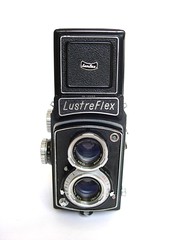 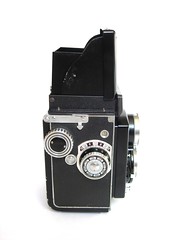 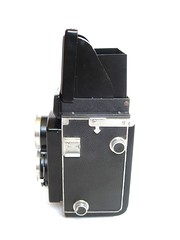 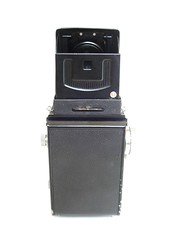
|
  
|
| Lustreflex "export model" no.13425, Tri-Lausar 8cm f/3.5 lenses, Synchro-Super shutter. Pictures courtesy of Richard J. Turner. (Image rights) |
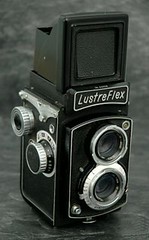
|
| Lustreflex "export model", later version. Picture courtesy of Alan Russell. (Image rights) |

|
| New LustreFlex nameplate, with serial number. (Image rights) |
The later models have a different LustreFlex nameplate (as opposed to Lustre flex), with a serial number engraved above. They were notably observed in Western online auctions, and might have been made for export only. All have Tri-Lausar Anastigmat 8cm f/3.5 lenses in CHY-FB, Synchro-Super or Synchro-MXV shutters.
The manual model is only known from McKeown, where it is called "Lustreflex (type 2)".[12] It is quite similar to the Lustreflex A, but for the Tri-Lausar lenses and CHY-FB shutter (B, 1–300).[13] It has a round red window in the back, protected by a vertically sliding cover, and a Lustre logo on the hood.
The more common semi-automatic model is called "Lustreflex (Export model)" by some sources.[14] Some examples are similar to the Lustreflex M, but the exposure counter window has moved towards the bottom; they have Tri-Lausar lenses and a Synchro-Super shutter (B, 1–300).[15] Some have the Lustre logo on the hood whereas others don't.
Other examples differ by the shape of the strap lugs: compare the two examples pictured in this page. At least one of them has a Synchro-MXV shutter (B, 1–500). It is engraved SYNCHRO–MXV at the bottom, with MXV in red, and has an M/X selector added next to the aperture scale.[16] This particular example has body no.13390, lower than the camera with older strap lugs pictured in this page (body no.13425). The strap lugs and other minor parts were probably not made by the company but bought from a subcontractor, and the mounting of these parts did not rigidly follow the production sequence.
Notes
- ↑ Advertisement in Sankei Camera, reproduced in Kokusan kamera no rekishi, p.204.
- ↑ Advertisements reproduced in Kokusan kamera no rekishi, p.204.
- ↑ Advertisement reproduced in Kokusan kamera no rekishi, p.204: ハレーション防止装置.
- ↑ Kokusan kamera no rekishi, p.371.
- ↑ Kokusan kamera no rekishi, p.371.
- ↑ Advertisement reproduced in Kokusan kamera no rekishi, p.205.
- ↑ Advertisement reproduced in Kokusan kamera no rekishi, p.205.
- ↑ Kokusan kamera no rekishi, p.371.
- ↑ Sugiyama, item 2147.
- ↑ Features: Kokusan kamera no rekishi, p.413.
- ↑ Kokusan kamera no rekishi, p.413.
- ↑ McKeown, p.640.
- ↑ Speeds: McKeown, p.640.
- ↑ Sugiyama, item 2148, McKeown, p.640.
- ↑ Example pictured in Sugiyama, item 2148, example pictured in here at tlr-cameras.com and example pictured in this page (body no.13425). Speed range reported only.
- ↑ Example observed in an online auction, body no.13390.
Bibliography
- Asahi Camera (アサヒカメラ) editorial staff. Shōwa 10–40nen kōkoku ni miru kokusan kamera no rekishi (昭和10–40年広告にみる国産カメラの歴史, Japanese camera history as seen in advertisements, 1935–1965). Tokyo: Asahi Shinbunsha, 1994. ISBN 4-02-330312-7. Items 986–9 and 1749.
- McKeown, James M. and Joan C. McKeown's Price Guide to Antique and Classic Cameras, 12th Edition, 2005-2006. USA, Centennial Photo Service, 2004. ISBN 0-931838-40-1 (hardcover). ISBN 0-931838-41-X (softcover). P.640.
- Sugiyama, Kōichi (杉山浩一); Naoi, Hiroaki (直井浩明); Bullock, John R. The Collector's Guide to Japanese Cameras. 国産カメラ図鑑 (Kokusan kamera zukan). Tokyo: Asahi Sonorama, 1985. ISBN 4-257-03187-5. Item 2147–8.
Links
In English:
- Lustre TLRs (with a Lustreflex) at tlr-cameras.com